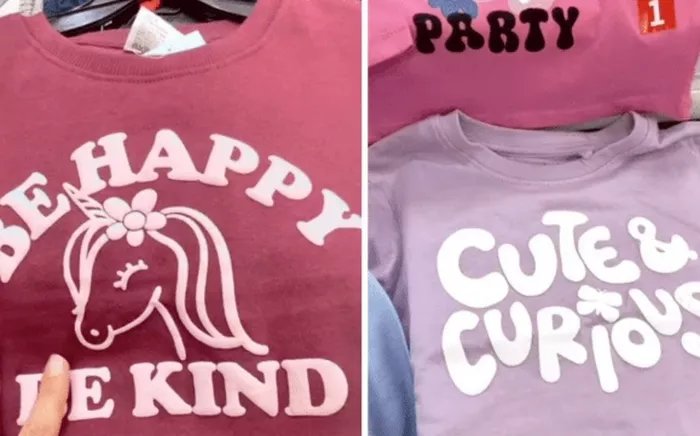When Big W changed its children’s clothing layout in late 2024 to a unisex format, Australian parents were split in opinion. Now, another major retailer is drawing attention for the opposite reason—highlighting distinct differences in clothing marketed to boys and girls.
Lisa, a mother from Adelaide, recently visited her local Best & Less in Fulham Gardens and was taken aback by what she saw on the clothing racks.
“I’ve long noticed the poor slogan choices for plus-size women’s shirts and have been vocal about it for years,” Lisa told Kidspot. “But this time, it was the messaging on kids’ shirts that caught my attention.”
In a TikTok video shared via her Curvature Clothing account, Lisa points out a stark contrast between the messages on boys’ and girls’ t-shirts.
“Just look at this,” she says in the clip. “These are the boys’ shirts—words like fearless, strong, build, unbeaten, danger.” She then compares them to girls’ shirts with slogans such as: “Be happy, be kind, cute kids club, flower party, cute and curious, smile.”
Lisa argues that while these phrases may appear harmless, they reflect deeply ingrained societal expectations. “The language on the girls’ shirts is so submissive and appearance-based, but it’s so normalised that people don’t even notice,” she says.
She explained to Kidspot that her intent in sharing the now-viral video—viewed over 71,000 times—was to raise awareness among parents about the subtle but significant impact of such messaging.
“My problem isn’t with people who buy or wear them, but with the brands that keep pushing these patronising slogans,” Lisa says. “It’s laughable how predictable they are—girls get passive phrases, boys get power statements. On the same day I saw this, there was a men’s t-shirt labeled ‘superior.’”
Lisa emphasizes that this issue has larger implications. “In a country where one woman a week dies at the hands of her partner, I don’t think it’s a stretch to say that messages like these are part of the problem,” she said. “They seem trivial, but they reinforce damaging norms.”
She hopes her video will prompt other parents to pause and think more critically about the language presented to their children through everyday clothing.
“I honestly hadn’t paid much attention to kids’ shirts before,” she said. “But my daughter is 9 now, and when she was younger, I would’ve bought shirts like these—cheap, easy options for daycare or playtime. I understand that parenting is hard and practicality often comes first.”
Still, Lisa believes brands must do better.
“My issue is with what’s printed on the clothing, not the parents who buy them,” she says. “For children, the message is clear—society has expectations for you, and they’re spelled out in bold letters on your shirt.”
She also points out the visual symbolism in clothing designs: “Boys get shirts with apex predators like lions and dinosaurs. Girls get butterflies and flowers. The message couldn’t be clearer.”
Lisa’s video struck a chord with many, as parents flooded the comments section in agreement.
“Subliminal messaging, totally agree,” one viewer wrote.
“Yes—it’s conditioning,” another commented.
A particularly striking observation came from someone who noted, “Boys’ clothes feature predators. Girls’ clothes have prey. It’s so unsettling.”
Some parents of boys also expressed concerns, saying they want their sons to be encouraged to show kindness and curiosity too.
“It’s concerning on both sides,” one parent noted. “Why can’t boys’ shirts say ‘be kind’ or ‘smile’ too?”
“I wish we taught boys to be happy and kind,” another agreed.
Others expressed frustration that this issue is still ongoing.
“I’m 60, and I can’t believe we’re still having this conversation,” one person commented.
For Lisa, the solution is simple and inclusive: “Just make the same slogan tees for both boys and girls.”
Related Topics
- SNL Mocks Forever 21’s Fall With ‘Forever 31’ Spoof, Highlighting the Brand’s Struggles to Keep Up with Consumers
- British Luxury Fashion Brand ME+EM Makes Bold Texas Debut at NorthPark Center in Dallas
- Folk Clothing Marks 25th Anniversary with Creative Collaborations and Community Support

